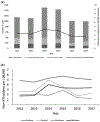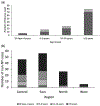Field investigation of high reported non-neonatal tetanus burden in Uganda, 2016-2017
- PMID: 36762894
- PMCID: PMC10413815
- DOI: 10.1093/ije/dyad005
Field investigation of high reported non-neonatal tetanus burden in Uganda, 2016-2017
Abstract
Background: Despite providing tetanus-toxoid-containing vaccine (TTCV) to infants and reproductive-age women, Uganda reports one of the highest incidences of non-neonatal tetanus (non-NT). Prompted by unusual epidemiologic trends among reported non-NT cases, we conducted a retrospective record review to see whether these data reflected true disease burden.
Methods: We analysed nationally reported non-NT cases during 2012-2017. We visited 26 facilities (14 hospitals, 12 health centres) reporting high numbers of non-NT cases (n = 20) or zero cases (n = 6). We identified non-NT cases in facility registers during 1 January 2016-30 June 2017; the identified case records were abstracted.
Results: During 2012-2017, a total of 24 518 non-NT cases were reported and 74% were ≥5 years old. The average annual incidence was 3.43 per 100 000 population based on inpatient admissions. Among 482 non-NT inpatient cases reported during 1 January 2016-30 June 2017 from hospitals visited, 342 (71%) were identified in facility registers, despite missing register data (21%). Males comprised 283 (83%) of identified cases and 60% were ≥15 years old. Of 145 cases with detailed records, 134 (92%) were clinically confirmed tetanus; among these, the case-fatality ratio (CFR) was 54%. Fourteen cases were identified at two hospitals reporting zero cases. Among >4000 outpatient cases reported from health centres visited, only 3 cases were identified; the remainder were data errors.
Conclusions: A substantial number of non-NT cases and deaths occur in Uganda. The high CFR and high non-NT burden among men and older children indicate the need for TTCV booster doses across the life course to all individuals as well as improved coverage with the TTCV primary series. The observed data errors indicate the need for data quality improvement activities.
Keywords: Tetanus; Uganda; booster immunization; data quality; public health surveillance; tetanus toxoid; vaccination.
Published by Oxford University Press on behalf of the International Epidemiological Association 2023.
Conflict of interest statement
Conflict of interest
None declared.
Figures




Similar articles
-
Vaccines for women for preventing neonatal tetanus.Cochrane Database Syst Rev. 2015 Jul 6;2015(7):CD002959. doi: 10.1002/14651858.CD002959.pub4. Cochrane Database Syst Rev. 2015. PMID: 26144877 Free PMC article.
-
The effect of pertussis vaccination in pregnancy on the immunogenicity of acellular or whole-cell pertussis vaccination in Gambian infants (GaPS): a single-centre, randomised, controlled, double-blind, phase 4 trial.Lancet Infect Dis. 2025 Aug;25(8):909-924. doi: 10.1016/S1473-3099(25)00072-6. Epub 2025 Mar 25. Lancet Infect Dis. 2025. PMID: 40154521 Clinical Trial.
-
Strategies to increase immunization coverage of tetanus vaccine among women in Sub Saharan Africa: a systematic review.Pan Afr Med J. 2017 Jun 22;27(Suppl 3):25. doi: 10.11604/pamj.supp.2017.27.3.11535. eCollection 2017. Pan Afr Med J. 2017. PMID: 29296160 Free PMC article.
-
Vaccines for women to prevent neonatal tetanus.Cochrane Database Syst Rev. 2013 May 31;(5):CD002959. doi: 10.1002/14651858.CD002959.pub3. Cochrane Database Syst Rev. 2013. Update in: Cochrane Database Syst Rev. 2015 Jul 06;(7):CD002959. doi: 10.1002/14651858.CD002959.pub4. PMID: 23728640 Updated.
-
Vaccines for preventing typhoid fever.Cochrane Database Syst Rev. 2018 May 31;5(5):CD001261. doi: 10.1002/14651858.CD001261.pub4. Cochrane Database Syst Rev. 2018. PMID: 29851031 Free PMC article.
Cited by
-
Tetanus: recognition and management.Lancet Infect Dis. 2025 Jun 18:S1473-3099(25)00292-0. doi: 10.1016/S1473-3099(25)00292-0. Online ahead of print. Lancet Infect Dis. 2025. PMID: 40543524 Free PMC article. Review.
References
-
- World Health Organization. Immunization, Vaccines and Biologicals. Vaccine Preventable Diseases Vaccines Monitoring System 2019 Global Summary Reference Time Series: TETANUS (TOTAL). https://immunizationdata.who.int/pages/incidence/TTETANUS.html?GROUP=Cou... (23 December 2022, date last accessed).
-
- World Health Organization. JRF Supplementary Questionnaire on Surveillance Global Immunization Monitoring and Surveillance (GIMS). 2017. https://cdn.who.int/media/docs/default-source/immunization/vpd_surveilla... (23 December 2022, date last accessed).
-
- World Health Organization. Vaccine Preventable Diseases Surveillance Standards. World Health Organization. 2018. https://apps.who.int/iris/handle/10665/275754 (23 December 2022, date last accessed).
-
- World Health Organization. Technical Guidelines for Integrated Disease Surveillance and Response in the WHO African Region. 2019. https://apps.who.int/iris/bitstream/handle/10665/325015/WHO-AF-WHE-CPI-0... (23 December 2022, date last accessed).
Publication types
MeSH terms
Substances
Grants and funding
LinkOut - more resources
Full Text Sources
Medical
Research Materials

